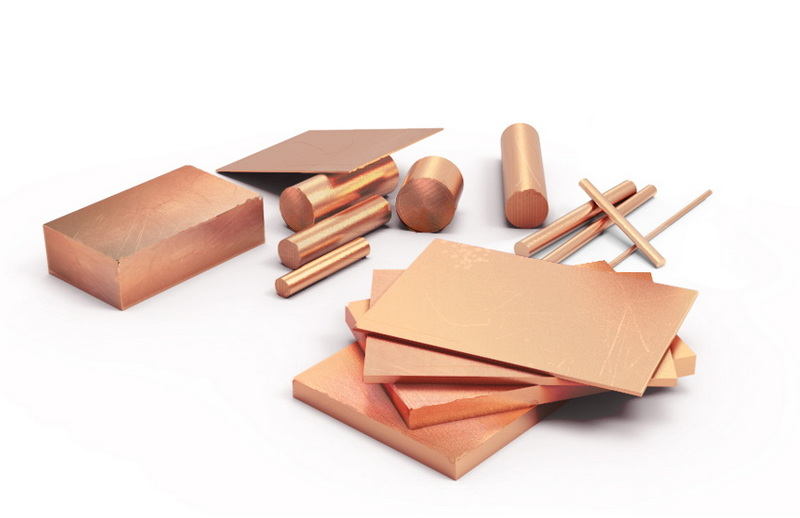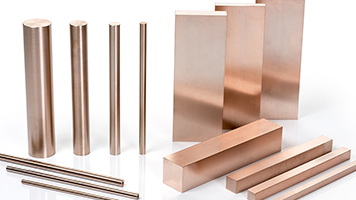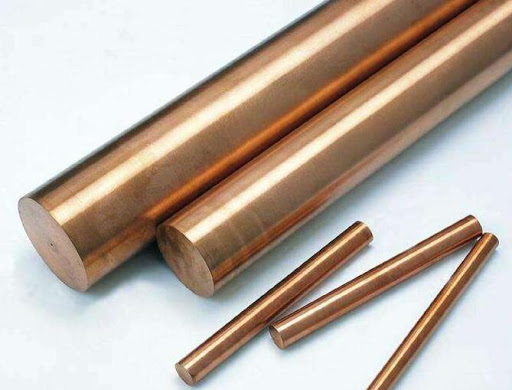Content Menu
● Introduction
● What Is TC5 Copper Tungsten Carbide?
● Typical Applications of TC5 Copper Tungsten Carbide
● Available Sizes of TC5 Copper Tungsten Carbide
● Manufacturing and Customization
● Visual Guide to TC5 Copper Tungsten Carbide Sizes
● Comparison with Other Copper Tungsten Carbide Grades
● Practical Considerations for Sizing
● Advanced Applications of TC5 Copper Tungsten Carbide
>> Aerospace Industry
>> Scientific Equipment
● Detailed Manufacturing Process
● Environmental and Economic Considerations
>> Environmental Impact
>> Cost Factors
● Future Trends in Copper Tungsten Carbide Materials
>> Emerging Technologies
● Conclusion
● Frequently Asked Questions (FAQ)
>> 1. What is the typical composition of TC5 copper tungsten carbide?
>> 2. What are the standard sizes available for TC5?
>> 3. What are the main applications of TC5 copper tungsten carbide?
>> 4. Can TC5 be machined to custom shapes and sizes?
>> 5. How does TC5 compare to other copper tungsten carbide grades?
Copper tungsten carbide alloys, especially the TC5 grade, are critical materials in industries that demand a balance of hardness, wear resistance, and excellent electrical and thermal conductivity. This article provides a comprehensive guide to the available sizes of TC5 copper tungsten carbide, its manufacturing process, advanced applications, and future trends. Throughout the article, you will find visual references and detailed explanations to help you understand every aspect of this versatile material.

Introduction
Copper tungsten carbide composites like TC5 are engineered to combine the strength and durability of tungsten carbide with the superior conductivity of copper. TC5 typically contains about 50% tungsten carbide and 50% copper by weight, making it ideal for applications where both mechanical integrity and efficient heat or electricity transfer are required. Engineers and procurement specialists need to be aware of the available sizes and customizability of TC5 to ensure optimal performance in their projects.
What Is TC5 Copper Tungsten Carbide?
TC5 is a composite material consisting of tungsten carbide grains dispersed in a copper matrix. This unique structure provides several advantages:
- High Hardness: The tungsten carbide component ensures resistance to wear and deformation under stress.
- Excellent Electrical Conductivity: The copper matrix allows for efficient electricity flow.
- Superior Thermal Conductivity: Heat is dissipated quickly, reducing the risk of component failure.
- Good Machinability: While challenging due to its hardness, TC5 can be machined with the right tools and techniques.
These properties make TC5 a preferred choice for demanding applications in both electrical and mechanical engineering.
Typical Applications of TC5 Copper Tungsten Carbide
TC5 is widely used in several key industries:
- Resistance Welding Dies: Ideal for light-duty projection welding where pressures are moderate.
- Electrical Contacts: Used in switches and connectors due to its resistance to arc erosion and stable conductivity.
- Die Inserts and Facings: Employed in projection, flash, and butt welding, as well as electroforging.
- Electrodes: Utilized in spot welding and other electrical joining processes.
The material's ability to withstand high temperatures and resist wear makes it indispensable in many industrial settings.
Available Sizes of TC5 Copper Tungsten Carbide
Understanding the available sizes of TC5 is crucial for specifying the right material for your application. While exact dimensions may vary by manufacturer, the following are typical size ranges for TC5 copper tungsten carbide:
- Round Rods: Commonly available in diameters from 3 mm (about 1/8 inch) up to 40 mm (about 1.6 inches).
- Flat Bars: Available in widths from 3 mm to 50 mm and thicknesses from 3 mm to 25 mm.
- Custom Shapes: Many suppliers offer custom machining of TC5 for die inserts, electrodes, or other specialized tooling.
Below is a summary table of standard size ranges:
| Shape | Size Range (mm) | Size Range (inches) |
| Round Rod | 3–40 | 1/8–1.6 |
| Flat Bar | 3–50 (width) | 1/8–2 (width) |
| 3–25 (thickness) | 1/8–1 (thickness) |
Custom orders are often required for non-standard dimensions, and lead times may be longer for specialized requirements.
Manufacturing and Customization
TC5 copper tungsten carbide is produced using advanced powder metallurgy techniques:
1. Mixing: Tungsten carbide and copper powders are blended in precise ratios.
2. Compaction: The mixture is pressed under high pressure to form a green body.
3. Sintering: The green body is heated to bond the powders together.
4. Infiltration: Molten copper is introduced to fill any remaining pores, resulting in a dense, homogeneous composite.
Quality control is rigorous throughout the process, with microstructural analysis and mechanical testing ensuring consistency and performance.
Visual Guide to TC5 Copper Tungsten Carbide Sizes
To help visualize the range of available sizes, consider the following illustrations:
- Round Rods: Various diameters from 3 mm to 40 mm.
- Flat Bars: Multiple width and thickness combinations.
- Custom Shapes: Examples of die inserts and electrodes.
These images demonstrate the versatility of TC5 and the range of sizes that can be obtained through standard and custom manufacturing.

Comparison with Other Copper Tungsten Carbide Grades
TC5 is one of several copper tungsten carbide grades available. The table below compares TC5 with other common grades:
| Grade | Composition | Typical Use |
| TC5 | 50% WC, 50% Cu | Light-duty projection welding dies |
| TC10 | 56% WC, 44% Cu | Mass production projection welding |
| TC20 | 70% WC, 30% Cu | Severe electrical upsetting |
| TC53 | 70% WC, 30% Cu* | Heavy-duty, high-strength dies |
Practical Considerations for Sizing
When selecting the size of TC5 copper tungsten carbide, consider the following factors:
- Application Requirements: The size must meet the mechanical and electrical demands of the application.
- Manufacturing Capabilities: The chosen size must be compatible with available manufacturing and machining processes.
- Cost: Custom sizes may incur additional costs due to increased material usage and machining complexity.
- Lead Time: Custom orders may require longer lead times than standard sizes.
Advanced Applications of TC5 Copper Tungsten Carbide
Beyond the common uses in resistance welding and electrical contacts, TC5 copper tungsten carbide finds applications in advanced industrial and scientific fields.
Aerospace Industry
In aerospace, TC5 components contribute to the reliability of electrical systems by ensuring stable conductivity and resistance to mechanical wear. This is particularly important in aircraft wiring and control systems where failure is not an option.
Scientific Equipment
TC5 is also employed in scientific instruments that require precise electrical contacts and thermal stability, such as particle accelerators and high-frequency communication devices.
Detailed Manufacturing Process
The production of TC5 copper tungsten carbide involves several critical steps:
1. Powder Mixing: Tungsten carbide and copper powders are blended to achieve the desired composition.
2. Compaction: The mixture is pressed into a green body under high pressure.
3. Sintering: The green body is heated to bond the powders together.
4. Infiltration: Molten copper is introduced to fill any remaining pores, resulting in a dense, homogeneous composite.
Throughout manufacturing, rigorous quality control measures are implemented, including microstructural analysis and mechanical testing, to ensure consistency and performance.
Environmental and Economic Considerations
Using TC5 copper tungsten carbide also involves considering its environmental impact and cost-effectiveness.
Environmental Impact
The material's durability reduces the frequency of replacements, contributing to sustainability. However, the production process is energy-intensive, and recycling options are limited due to the composite nature.
Cost Factors
The cost of TC5 varies depending on the purity of materials, manufacturing complexity, and customization requirements. Bulk orders and standard sizes typically offer better pricing.
Future Trends in Copper Tungsten Carbide Materials
Research continues to improve copper tungsten carbide composites, focusing on enhancing thermal conductivity, wear resistance, and machinability.
Emerging Technologies
Advancements in additive manufacturing (3D printing) are beginning to influence the production of copper tungsten carbide components, allowing for more complex geometries and reduced waste.
Conclusion
TC5 copper tungsten carbide remains a vital material in various industries due to its unique combination of hardness, conductivity, and durability. Expanding its applications and improving manufacturing techniques will likely increase its importance in future technological developments.
Understanding the detailed sizes, manufacturing processes, and emerging trends helps engineers and buyers make informed decisions when selecting TC5 for their projects.

Frequently Asked Questions (FAQ)
1. What is the typical composition of TC5 copper tungsten carbide?
TC5 is typically composed of 50% tungsten carbide and 50% copper by weight. This combination provides a balance of hardness, wear resistance, and good electrical and thermal conductivity.
2. What are the standard sizes available for TC5?
Standard sizes for TC5 include round rods from 3 mm to 40 mm in diameter and flat bars in widths up to 50 mm and thicknesses up to 25 mm. Custom sizes are also available from most manufacturers.
3. What are the main applications of TC5 copper tungsten carbide?
TC5 is primarily used for light-duty projection welding dies, electrical contacts, and as die inserts for various welding and forging applications.
4. Can TC5 be machined to custom shapes and sizes?
Yes, TC5 can be custom machined to specific dimensions and shapes, such as die inserts or electrodes, to meet the requirements of unique applications.
5. How does TC5 compare to other copper tungsten carbide grades?
TC5 is designed for light-duty applications, offering a good balance of hardness and conductivity. Other grades, such as TC10 and TC20, are used for more demanding applications requiring higher strength or wear resistance.
















